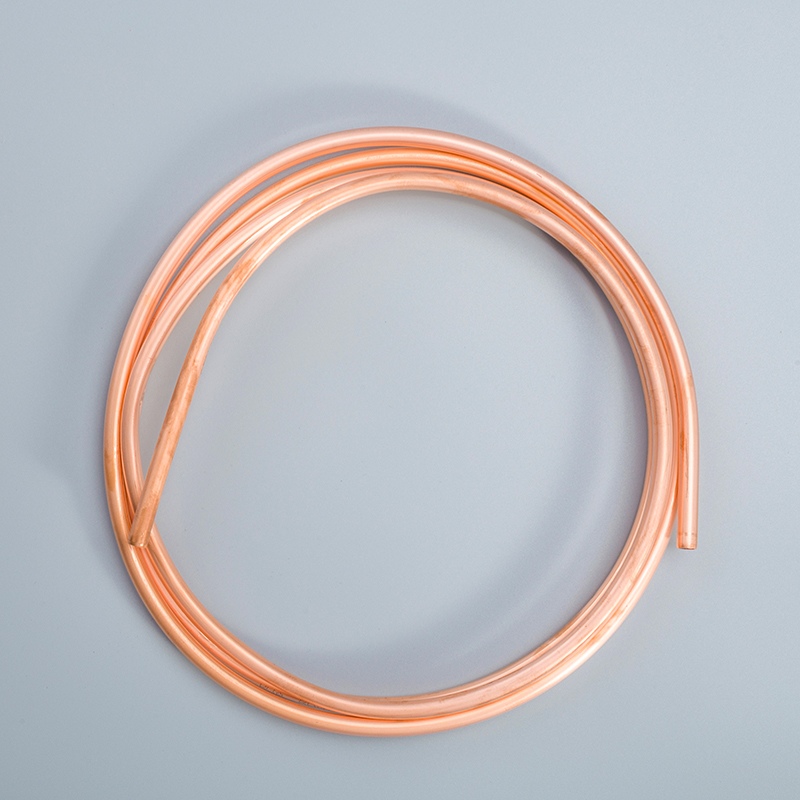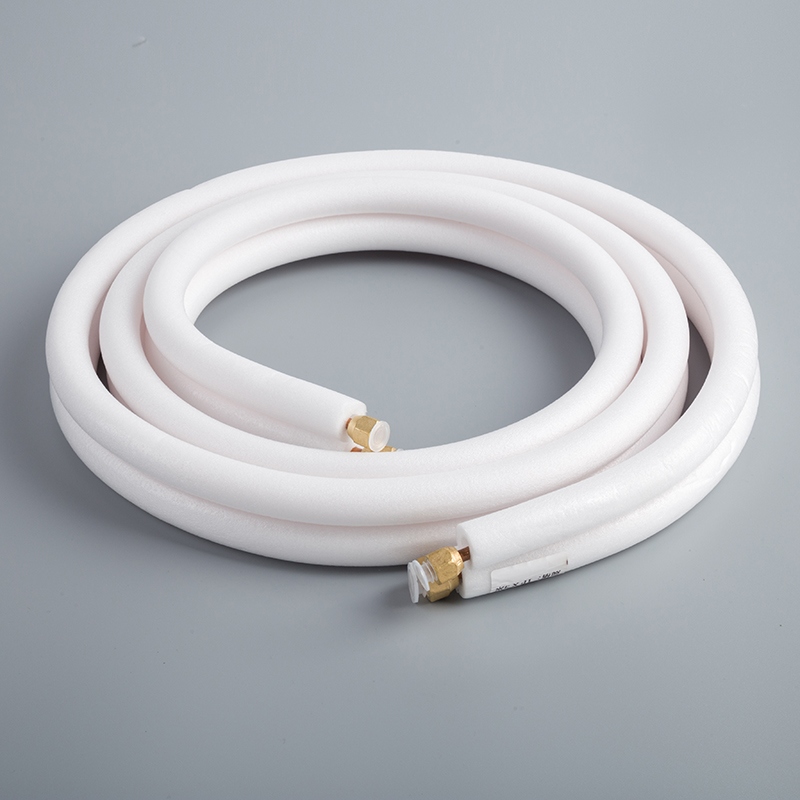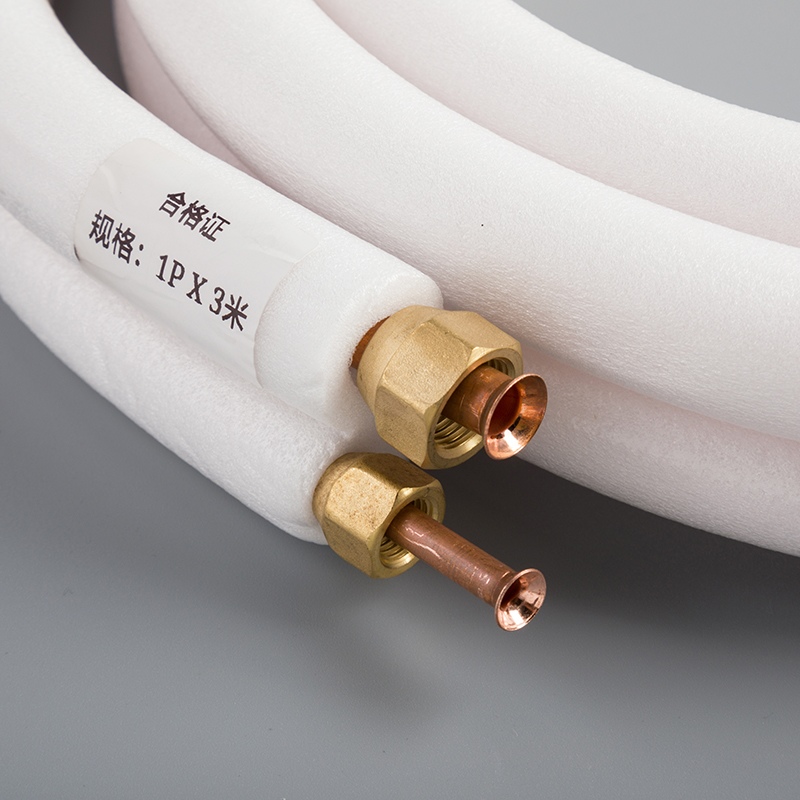How to Choose the Right Copper Pipe Size for Your Air Conditioner

Choosing the right copper pipe size for your air conditioner is essential for maintaining its performance and efficiency. A properly sized pipe ensures smooth refrigerant flow, which keeps your system running at its best. Incorrect sizing can lead to reduced cooling, higher energy bills, or even damage to your air conditioner. For example, a pipe that’s too small may restrict refrigerant flow, while an oversized pipe can cause pressure imbalances. By understanding the importance of copper pipe size for air conditioner systems, you can avoid costly repairs and enjoy consistent cooling.
Key Takeaways
Picking the right copper pipe size is important for your air conditioner to work well.
Use Type L or Type K copper pipes because they are strong and handle pressure well.
Figure out how much cooling your space needs to choose the right pipe size for good refrigerant flow.
Check manufacturer instructions and ask HVAC experts to make sure you pick the right pipe size and avoid expensive errors.
The right pipe size can make your system work better, save energy, and stop problems.
Understanding Copper Pipes
Types of Copper Pipes
Soft vs. Hard Copper Pipes
Copper pipes come in two main forms: soft and hard. Soft copper pipes are flexible and easy to bend, making them ideal for installations requiring tight turns or custom shapes. You can use them in areas where rigid pipes would be difficult to fit. Hard copper pipes, on the other hand, are rigid and durable. These pipes are often used in fixed installations where strength and stability are essential. While soft pipes offer versatility, hard pipes provide long-term reliability.
Common Grades (Type L, Type K)
Copper pipes are also categorized by grades, with Type L and Type K being the most common in air conditioning systems. Each grade has unique characteristics that make it suitable for specific applications:
Thickest walls, offering exceptional durability.
Ideal for high-pressure applications and underground installations.
Type L Copper Pipes:
A balance between wall thickness and flexibility.
Commonly used in residential and commercial air conditioning systems.
Excellent corrosion resistance, making them suitable for both indoor and outdoor use.
Characteristic | Type K Copper Pipe | Type L Copper Pipe |
|---|---|---|
Wall Thickness | Thickest walls, very durable | Moderately thick walls, versatile |
Pressure Resistance | High pressure applications | Moderate pressure applications |
Corrosion Resistance | Excellent, suitable for harsh environments | Good, ideal for indoor and outdoor use |
Cost | More expensive due to thickness | More affordable, good balance of cost |
Best Applications | Underground installations, high-pressure | Residential and commercial AC systems |
Properties of Copper Pipes
Durability and Corrosion Resistance
Copper pipes are known for their exceptional durability. With proper installation and maintenance, they can last over 50 years. Unlike galvanized steel pipes, which are prone to rust and have a shorter lifespan, copper resists rust, corrosion, and erosion. This makes it a reliable choice for air conditioning systems exposed to varying environmental conditions. Copper also maintains its performance under high pressures and temperatures, ensuring long-term efficiency.
Thermal Conductivity in Air Conditioning
Copper’s high thermal conductivity plays a critical role in air conditioning systems. It transfers heat nearly 60 times faster than stainless steel, allowing for rapid heat exchange. This efficiency ensures that your system regulates temperature effectively, keeping your home or office comfortable. Copper’s ability to handle heat transfer efficiently makes it a preferred material for air conditioning pipes, enhancing the overall performance of the system.
Standard Copper Pipe Sizes

Dimensions and Measurements
Inner Diameter vs. Outer Diameter
When selecting copper pipe sizes for air conditioning systems, understanding the difference between inner and outer diameters is crucial. The inner diameter determines the space available for refrigerant flow, while the outer diameter includes the pipe's wall thickness. Both measurements affect system performance.
Properly sized pipes ensure efficient refrigerant transport and reduce energy consumption.
Smaller diameter pipes can improve efficiency by lowering operational costs.
Incorrect sizing may lead to reduced cooling or increased wear on the system.
By focusing on these dimensions, you can maintain the reliability and energy efficiency of your air conditioning system.
Common Sizes for Residential and Commercial Systems
The common sizes of copper pipes used in air conditioning systems vary based on the application. Residential systems typically use smaller pipes, while commercial systems require larger ones to handle higher capacities. Below is a table summarizing standard dimensions:
Dimension Type | Measurement Range |
|---|---|
Nominal Pipe Size (NPS) | Varies by application |
Outside Diameter (OD) | |
Wall Thickness | Varies based on pressure needs |
This table provides a quick reference for selecting the right pipe size for your system.
Classification Standards
HVAC Pipe Size Classifications
Copper pipe sizes for HVAC systems follow specific classifications to ensure compatibility and performance. These classifications consider factors like refrigerant type, pressure levels, and system capacity. By adhering to these standards, you can avoid mismatched components and maintain system efficiency.
Matching Pipe Size to System Specifications
Matching the pipe size to your air conditioning system's specifications is essential. Manufacturers often provide detailed guidelines in their manuals. These recommendations account for factors like cooling capacity, refrigerant type, and installation environment. Following these specifications ensures optimal performance and prevents potential issues like pressure imbalances or refrigerant leaks.
Factors in Choosing the Right Copper Pipe Size
System Capacity
Cooling Capacity and Pipe Size
The cooling capacity of your air conditioning system plays a significant role in determining the copper pipe size. Larger systems require pipes with wider diameters to handle the increased refrigerant flow. This ensures the system operates efficiently without overloading. On the other hand, smaller systems can use narrower pipes, which help maintain proper pressure levels. To select the right pipe size, you need to calculate the cooling load of your space. This calculation helps you match the pipe size to the system's cooling requirements, ensuring optimal performance.
Larger systems demand greater refrigerant flow, requiring wider pipes.
Smaller systems benefit from narrower pipes for better pressure control.
Load calculations are essential for determining the appropriate pipe size.
Compressor and Evaporator Requirements
The compressor and evaporator in your air conditioning system also influence the choice of copper pipe size. These components rely on the correct refrigerant flow to function effectively. Pipes that are too small may restrict refrigerant movement, causing strain on the compressor. Oversized pipes, however, can lead to inefficient cooling and pressure imbalances. Always consider the specifications of these components when choosing the right copper pipe size for your air conditioner.
Installation Environment
Pipe Length and Bends
The length of the copper pipe and the number of bends in the installation affect its performance. Longer pipes or those with multiple bends can increase resistance to refrigerant flow. This may require you to choose a slightly larger pipe size to compensate for the added resistance. Outdoor installations often face additional challenges, such as exposure to temperature fluctuations and physical stress. In such cases, pipes with thicker walls provide better durability and reliability.
Longer pipes increase resistance, requiring larger diameters.
Multiple bends can reduce refrigerant flow efficiency.
Outdoor installations need durable pipes to withstand environmental stress.
Indoor vs. Outdoor Installations
The location of your air conditioning installation impacts the type of copper pipe you should use. Indoor installations typically face fewer environmental challenges, allowing for more flexibility in pipe selection. Outdoor installations, however, demand pipes that can endure harsh conditions, such as extreme temperatures and physical wear. Choosing the right copper pipe size for outdoor use ensures your system remains efficient and long-lasting.
Pressure and Refrigerant Type
Refrigerant Type and Pipe Size
The type of refrigerant used in your air conditioning system directly affects the pipe size. Different refrigerants have unique pressure and flow characteristics. For example, systems using R-410A refrigerant often require pipes with specific diameters to maintain proper flow rates. Always check the refrigerant specifications when selecting the copper pipe size for your air conditioner.
Maintaining Proper Pressure Levels
Maintaining the correct pressure levels in your air conditioning system is crucial for its performance. Pipes that are too small can cause pressure to build up, leading to system inefficiencies or damage. Conversely, oversized pipes may result in low pressure, reducing cooling effectiveness. By selecting the appropriate pipe size, you can ensure your system operates at the ideal pressure, maximizing its efficiency and lifespan.
Practical Applications of Copper Pipe Sizing

Residential Systems
Typical Pipe Sizes for Homes
In residential air conditioning systems, copper pipe sizes typically range from 1/4 inch to 3/4 inch in outer diameter. These sizes are ideal for handling the refrigerant flow required by smaller systems. The choice of pipe size depends on the cooling capacity of your unit and the layout of your home. For example, a compact system in a single-story house may use narrower pipes, while a larger system in a multi-story home might require slightly wider pipes to maintain efficiency. Selecting the correct size ensures your system operates smoothly and avoids unnecessary strain on components like the compressor.
Challenges in Residential Installations
Installing copper pipes in residential settings can present several challenges. You may encounter issues such as:
Corrosion, including pitting corrosion, which can lead to leaks.
Pinhole leaks that are difficult to detect and may cause water damage.
Water quality concerns due to interactions between copper and water chemistry.
High initial costs compared to alternative materials like PVC or PEX.
Installation complexity requiring skilled labor and specialized tools.
Risk of theft because of the high value of copper.
Addressing these challenges requires careful planning and professional expertise. Proper installation and maintenance can help you avoid costly repairs and ensure the longevity of your air conditioning system.
Commercial Systems
Larger Pipe Sizes for High-Capacity Systems
Commercial air conditioning systems demand larger copper pipe sizes to accommodate higher refrigerant flow rates. These pipes typically range from 1/8 inch to 1-3/8 inches in outer diameter, depending on the system's capacity. Larger systems require pipes with greater diameters to handle the increased cooling load efficiently. Additionally, thicker pipe walls are essential for durability in high-pressure applications. Choosing the right size and thickness ensures your system performs reliably under demanding conditions.
Special Considerations for Commercial Use
When selecting copper pipes for commercial air conditioning systems, you need to account for several factors:
Load Calculations: Determine the cooling capacity required based on room size, insulation, and climate.
Efficiency Considerations: Smaller diameter pipes can improve energy efficiency and reduce operational costs.
Consulting Professionals: HVAC technicians can provide tailored advice to ensure proper pipe sizing.
Industry Standards: Following established guidelines ensures safety and reliability in pipe selection.
By addressing these considerations, you can optimize the performance and efficiency of your commercial air conditioning system while minimizing long-term costs.
Steps to Select the Right Copper Pipe Size
Perform Load Calculations
Calculating Cooling Load
Accurate cooling load calculations are essential when choosing the right copper pipe size for your air conditioner. These calculations help you determine the cooling capacity required for your space, ensuring efficient refrigerant flow. To perform these calculations:
Evaluate insulation quality to understand heat retention.
Consider the climate conditions in your area.
By following these steps, you can select a copper pipe size that matches your system's cooling needs, improving its performance and efficiency.
Tools for Accurate Calculations
Using the right tools makes cooling load calculations more precise. Some recommended tools include:
HVAC Load Calculator: This tool estimates the equipment capacity needed for your space.
Manual J Calculation Method: Developed by the ACCA, this method ensures accurate sizing of HVAC units.
These tools simplify the process and help you make informed decisions about copper pipe size for air conditioner systems.
Follow Manufacturer Guidelines
Importance of Manufacturer Recommendations
Manufacturers provide specific guidelines for selecting copper pipe sizes. Following these recommendations ensures your air conditioning system operates efficiently and lasts longer. Proper sizing prevents issues like refrigerant leaks and system inefficiencies. Consulting these guidelines also helps you avoid costly repairs and replacements.
Finding Specifications in Manuals
You can find copper pipe size specifications in the system's manual. These guides often include tables with . For example:
Diameter (in inches) | Diameter (in mm) |
|---|---|
1/4'' | 6.35 mm |
3/8'' | 9.52 mm |
1/2'' | 12.70 mm |
5/8'' | 15.88 mm |
3/4'' | 19.05 mm |
Referring to these specifications ensures you select the correct copper pipe size for your air conditioner.
Consult Professionals
Benefits of Professional Advice
Consulting HVAC professionals offers several advantages. Experts evaluate your system's unique requirements and recommend suitable copper pipe sizes. They also help you avoid potential pitfalls, such as mismatched components or improper sizing. Following their advice ensures your air conditioning system operates safely and reliably.
Ensuring Proper Pipe Sizing
Professional advice guarantees proper pipe sizing by adhering to industry standards. Technicians assess your system's cooling load and specifications, ensuring the selected pipe size meets all requirements. This approach enhances system efficiency, reduces energy costs, and extends the lifespan of your air conditioning system.
Selecting the right copper pipe size for your air conditioner ensures efficiency, longevity, and cost savings. Proper sizing optimizes refrigerant flow, reduces energy consumption, and prevents leaks or pressure drops.
Benefits of correct sizing include:
Enhanced system efficiency and reduced operational costs.
Prevention of performance issues like refrigerant leaks.
Cost-Saving Benefits | Description |
|---|---|
Energy Efficiency | Smaller pipes improve efficiency, lowering energy use. |
Operational Cost Reduction | Proper sizing minimizes long-term expenses. |
Reduced System Charge | Optimized pipe size decreases refrigerant needs, saving money. |
If you're unsure, consult HVAC professionals. They assess system requirements and recommend the best pipe size for optimal performance.
FAQ
What happens if you choose the wrong copper pipe size?
Using the wrong size can reduce cooling efficiency, increase energy costs, or damage your system. A pipe that’s too small restricts refrigerant flow, while an oversized pipe causes pressure imbalances. Always match the pipe size to your system’s specifications for optimal performance.
Can you use any type of copper pipe for air conditioners?
No, not all copper pipes are suitable. Type L and Type K pipes are commonly used due to their durability and pressure resistance. Soft copper pipes work well for flexible installations, while hard pipes are better for fixed setups. Always check your system’s requirements.
How do you measure copper pipe size?
Measure the outer diameter (OD) for classification and the inner diameter (ID) for refrigerant flow capacity. Use a caliper or pipe sizing chart for accuracy. Both measurements are critical for ensuring proper system performance and efficiency.
Do longer pipes require a different size?
Yes, longer pipes or those with multiple bends increase resistance to refrigerant flow. You may need a slightly larger diameter to maintain efficiency. Consult your system’s manual or an HVAC professional to determine the correct size for longer installations.
Should you consult a professional for pipe sizing?
Yes, consulting an HVAC professional ensures accurate pipe sizing. Experts consider factors like cooling load, refrigerant type, and installation environment. Their advice helps you avoid costly mistakes and ensures your air conditioner operates efficiently and reliably.
See Also
The Benefits of Selecting Copper Pipes for AC Systems
Five Key Considerations for Selecting Copper Pipe Size
The Importance of Pure Copper Pipes in AC Efficiency


